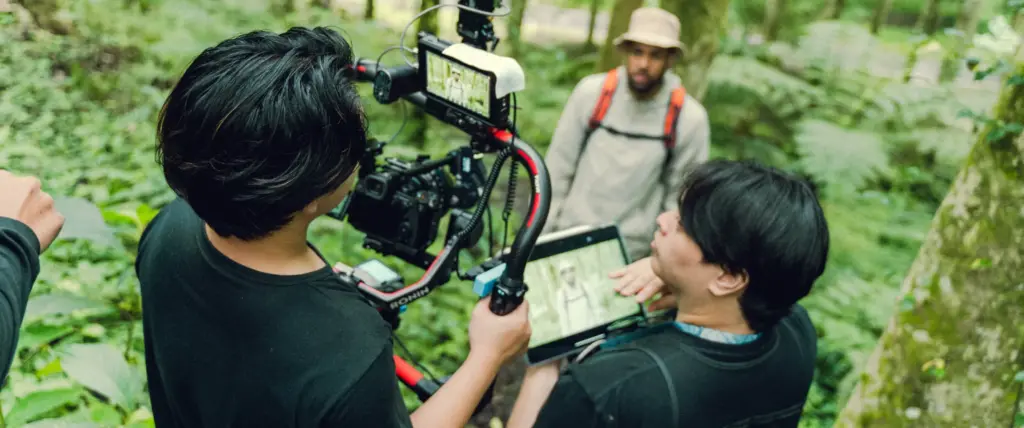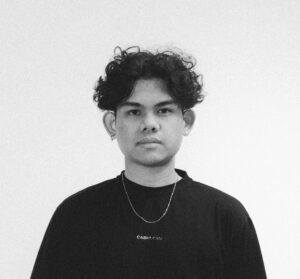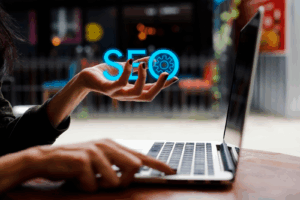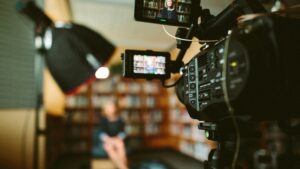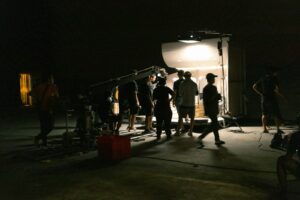Remote video production is a recommended solution to get budget efficiency in video shooting. Clients can be in any location while the film crew performs the shooting procedures from their base location. SNXP Studio is a production house that can implement remote shooting in its best practices.
SNXP Studio can provide live communication, live feedback, and live streaming in every remote shooting session. Clients do not need to worry about the quality even though shooting is done remotely because we focus on various aspects of quality as well. Let’s explore more about remote shooting solutions from SNXP Studio.
About SNXP Studio Remote Shooting

Some called it remote shooting, and some called it remote production. This method has a video production approach innovatively, with the subject matter located differently from the technical operator. To ensure the performance remains superior, various advanced technologies are used.
Dispatchers can control essential equipment including cameras even remotely. What about the quality of the content? You don’t need to worry about the quality of the remote shooting results because they are still of high quality. Such satisfactory production results can be obtained without the relevant operator having to be in the same location as the subject or model.
Initially, this remote video production innovation was for the needs of shooting under pandemic conditions. However remote media production remains popular until now and has even become a trend in itself. Remote shooting makes content creation from anywhere, in other words, much more efficient shooting.
So what benefits can we get from remote shooting? There are quite a few aspects that make this innovation a shooting trend. Cost-effectiveness is one of the goals of many people who are interested in remote video production. One of the essential points of remote shooting is that camera operators can easily manage their cameras even from a distance.
You don’t have to worry about big costs, be it renting more expensive equipment, lodging, travel, and various other costs. If you want to save time, then remote shooting can also be a reliable solution. Shooting remotely means you don’t have to spend a lot of time setting up more complex equipment or dismantling it.
The time saved can be utilized for more optimal shooting activities. But, certain extra preparations are needed to optimize a remote shooting session. Technology for remote video production includes remote camera control equipment, video conferencing software, and more.
Fast internet is also a key requirement to support remote shooting activities. Dispatchers can easily control various aspects ranging from zoom, focus, and camera angle even from a distance. They can also communicate live with the subject in real-time. Therefore, remote shooting requires software with video conferencing functions in the process.
The function of remote shooting is very widespread whether it is for the benefit of companies, or other organizations. You can use this innovative shooting service for live-streaming productions, virtual events, visual branding programs, or to create corporate videos.
How Remote Shooting Works?

Ever wonder how remote shooting or remote video production works? You might be surprised because a photo shoot is supposed to bring every division together to work together. But remote shooting is an efficient innovation and you can get the most out of it.
The first thing to do to start shooting is for the camera operator to connect to the camera. They have to adjust various key settings be it exposure, focus, zoom, and other important setting aspects. Amazingly, the operator can control the moving camera even remotely.
The result is that you can get footage captured from various angles. In some cases, the camera can be moved around the room to get a full view of the room. To support the full performance of remote video production, high-quality communication is required.
Communication is an important aspect that needs to be underlined so that its smoothness must be well maintained, especially the communication between the subject and the camera operator. Each other will use conferencing software to support communication in the form of real-time video.
The camera operator can give directions to the subject through the software including for live feedback. The various feedback details needed including voice recording, lighting, camera angles, and so on can be supported by adequate conferencing software.
You don’t have to worry about the smoothness of the process, now that the innovation and technology of remote shooting has been far developed.
Camera operators can adjust various aspects of photography remotely or from their location. This superior level of control ensures that the quality of the footage remains relevant and consistent. Ultimately, the video production can match the specifications required by the client.
In the world of remote shooting, certain specialized equipment is required including cameras that have sufficient remote control specifications. For camera movement control, certain software with such functions is also required.
For various live approaches such as live communication, live feedback, and live streaming to perform at their best, a stable internet connection is required. Various audio-video equipment must of course be prepared with the best as well so that the shooting session can run as expected.
Production houses that provide remote video production services can work on their turf even when clients are in different locations. SNXP Studio is an example of how a production house can deliver superior performance in remote shooting.
We can serve the needs of remote shooting as a whole, clients can get access to live communication, live feedback, and live streaming. Wherever the client is located, SNXP Studio will work on remote shooting projects from Indonesia (mostly Bali and Jakarta). Even though it is done remotely, you don’t need to worry about the quality.
Remote Shooting Type: Single Camera & Multi-Camera
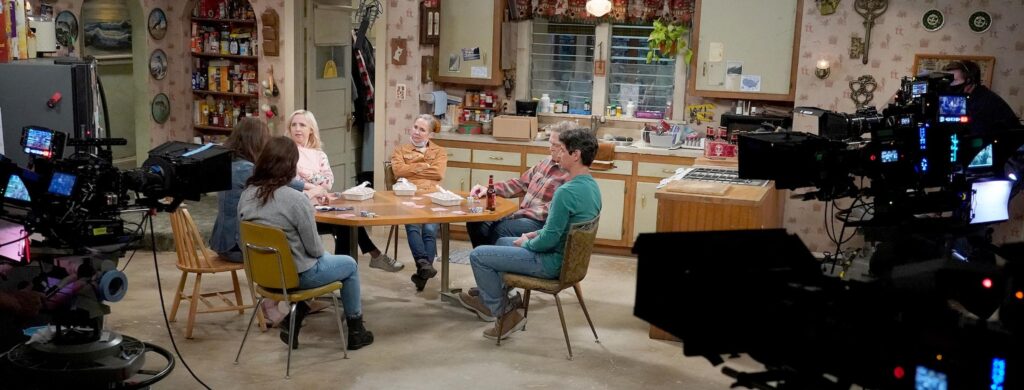
Each client may have a different vision, which is why remote shooting can be executed in single-camera or multi-camera usage. Let’s explore more about these two types of remote shoots:
– Single-camera
For the single-camera shooting method, one camera needs to be set up according to the location of the subject in question. Meanwhile, the camera operator can perform various controls even remotely. This method tends to be simple, making the process easier, while the cost is also lower.
While this is a win-win solution, there are certain limitations to be aware of. The camera operator may not be able to capture the event footage from enough angles. Another limitation that may be faced is that the camera operator may not be able to capture multiple subjects at once.
– Multi-camera
Multi cameras have higher functionality than single cameras in remote shooting sessions. Multiple cameras will be set up at a specific location where the subject or model is located. Similar to the single-camera remote shoot method, the operator will control the cameras remotely.
The interesting thing about remote shooting using the multi-camera method is that the footage can be captured from various angles. The advantage of multi-angle capture is that clients can get a more immersive experience with more comprehensive and dynamic video visuals.
To optimize shooting with multiple cameras, more complicated preparations are needed. As for the cost, it is more expensive when compared to the single-camera method.
These are the two main methods of how remote video production works. Both require specialized equipment, and the software used for video conferencing must be able to function optimally to support live communication. Both also require software to support camera movement control.
If you want to be more cost-effective, the single-camera method is something to consider but there are more limitations than multi-camera. While multi-camera requires higher costs with more complicated preparations as well. Multi-camera can be considered for a more immersive video production or streaming experience as it can go through various shooting angles.
Remote Shooting: What Are the Most Ideal Video Types?

The growing popularity of remote shooting has made many people interested in this much more efficient shooting method. Even so, some people may be confused about what videos to use this shooting service for. Don’t worry, as various types of videos are ideal for processing through the remote shooting method.
Here are some types of videos that are ideal to shoot using remote shooting:
– Interview video
Interviews at their best can be conducted even from a distance, which is one example of remote shooting. State-of-the-art video conferencing software can support the smooth production or streaming of video interviews.
– Tutorial video
Another type of video that is suitable for remote shooting is video tutorials. To support employee training sessions, companies can consider this much more efficient video production and management. Companies can organize e-learning courses, or training sessions for their employees.
– Testimonial video
Testimonials can boost a brand’s credibility and producing or broadcasting testimonial videos can be done even remotely. Clients or customers can recount their experiences in the form of video visuals on their turf. They may be more sincere if they share their testimonials on their premises.
– Company video
To convey the company’s message in the form of a video, you can use remote video production. The team leader does not have to be in the same location as the employee. In addition to live streaming, the video can also go through further stages to be ready for sharing on social media or other platforms.
How SNXP Studio Does Advanced Remote Shooting?

SNXP Studio can cut the complex process of video shooting to make it simpler but still maintain good quality. Recently, more and more of our clients are turning to remote video production. One of the main reasons is to reduce the project budget for making the video.
While this approach may not make sense at first, it has good results despite its simplicity. To achieve the vision of remote shooting with the best performance, SNXP Studio relies on several advanced technologies. Let’s explore further!
– Streaming Motion
For motion streaming, a basic setup is sufficient, this setup allows optimal communication with the client/director even if they are not on set. Communication can be done without delay and with easy procedures. So how does it work? Let’s find out more.
1. 4K Cam Link: Basic Setup
We work with Elgato 4K Cam Link for live streaming without HDCP encryption and HDMI output through any camera. This system is easy to run because almost all types of digital motion cameras are compatible with it. We can rely on this system but it may be more suitable for simple audio setups.
We rely on the on-board mic as the only audio system active during the broadcast. The computer and camera will be interconnected while the crew will use YouTube Live to broadcast it and can also go through Zoom for optimal conference call needs.
Video recordings are displayed at 1080p resolution on Zoom without much latency. In many cases, only 2 frames latency so we can get a near real-time experience to support live feedback with clients.
While this is YouTube Live, the recording can reach 4K although the delay may be quite large at around 10 seconds. Choosing this method needs extra consideration, some specific projects may not be ideal with this approach.
So, if you just want a live feed, you can consider the Zoom method. Meanwhile, if you want high-resolution video playback, you can consider the YouTube Live method. Most people now have both apps, which makes the process easier.
Not only do we focus on the camera feed, but we also install webcams in the relevant locations. You can know the real conditions of crew activities and various settings. Clients can also communicate easily with various departments. So what can we conclude? Here are some of the advantages of this setup.
- Supports optimal communication directly with those working on set
- Can stream more flexibly, streaming can be done anywhere
- Almost zero delay (camera to streaming output)
- Link more easily to YouTube or Zoom
- Costs less than the advanced ones
- More simpler setup, less time to prepare and dismantle equipment. Less time spent moving from one location to another.
While there are many benefits to the basic setup, there are certain aspects to consider. A basic setup may not be ideal for complex technical shoots and cannot use overlays or mixes. More than that, a basic setup makes everyone witness the same view on the feed and this setup is ideal only for simple audio setups.
2. QTAKE: Advanced Setup
If you are working on a project that is more technically complex or has a larger scope, then you might need an advanced setup more. Advanced setup has extra advantages and every advantage of basic setup is available in advanced setup.
QTAKE is a common software for VT in a shooting environment. QTAKE Server’s functionality is essential to support the vision of the production industry. You will be able to use overlays and mixes to support complex technicalities so that you can more easily adapt to various projects.
Another benefit is that it can support more complex audio settings than the basic setup so that it can support playback feeds and live streaming. Each person watching the stream has their playback.
Meanwhile, VT operators have access to customize who members are watching during playback and live streaming. Those who stream can either view, comment, adjust certain settings, or control playback. All of this can be done easily with QTAKE Monitor.
With the many benefits of advanced setup, it requires advanced technology to support it properly. Advanced setup requires stable and fast internet.
Obstacles are sometimes found due to location factors that do not support adequate internet access, especially outdoors. For high-resolution streaming needs, a high enough bandwidth will be needed so that it can run smoothly without problems. If the location concerned is remote locations, then you can consider a basic setup to support efficient procedures.
To understand more about advanced setup using the QTAKE system, check out some of the pros of the method:
- Supports direct communication with on-site personnel
- Flexible streaming anywhere
- Minimal delay, almost none
- Control video playback
- Works well with a variety of audio setups
- Easily link to QTAKE Monitor, YouTube, and Zoom
- Provide overlay and mix option
- Supports commentary via streaming apps
- Each member has an individual stream
Those are some of the benefits that you can find in an advanced setup. With a larger setup, of course, it takes more time to set up and tear down. Changing the filming location might put a strain on the production schedule management.
On the other hand, the internet connection setup must be stable and powerful enough to ensure every online progress goes smoothly. When compared to the basic setup, the advanced setup is more expensive.
– Streaming Stills
Some clients need to shoot moving images, so they will need motion streaming. SNXP Studio not only provides support for streaming motion but also optimal support for shooting stills.
Streaming services have equally important benefits for stills production but are much easier than motion streaming. In the case of stills shooting, photographers usually shoot tethered to a computer system.
The visual images will be lightly processed so that the client can comfortably see the conditions on set. Most of the live-streaming procedures are the same but we rely on Zoom so that the client can check each shot.
This system is especially useful if the client needs to mark which shots are their favorites and this is usually necessary if there is a tight deadline. We use a remote mouse such as the Team Viewer app so that the client can easily control the mouse. The client can view and then mark shots as the shoot progresses.
You can rely on SNXP Studio for remote video production projects. You may think of other shooting methods but you may have to pay too much or even less convenient for your shooting vision. To be more efficient in the budget, you can consider remote video production from SNXP Studio.
Exploring More Complete Benefits From Remote Shooting
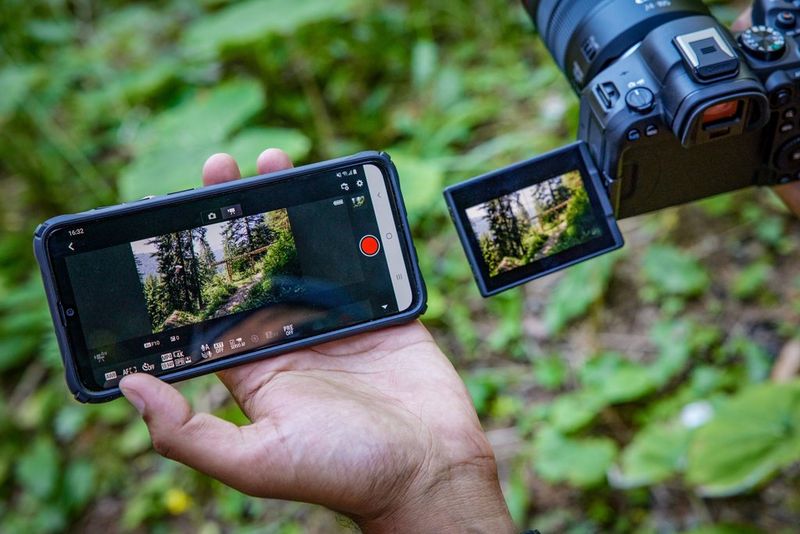
Remote shooting can provide more benefits than you might think. It is an innovation in the world of movie production that is more efficient, including in terms of budget. The flexibility of remote shooting is also very high, wherever the client is, the shooting procedure can still be done and they can expect an immersive experience.
Let’s explore more about the benefits of remote video production:
– Boosting Efficiency Yet Productivity
Unlike the traditional shooting method which requires the film crew to be at the relevant physical location to do their job which is to shoot the video. The crew must return first before the next project is executed.
Such traditional film procedures will limit the number of projects to be undertaken. At any one time, only one video production or broadcasting project may be handled. Remote video production can make it possible to handle multiple projects in a day.
With the multi-camera method, shots can be taken of multiple participants at the same time and each has their recordings.
– Cheaper Video Shooting Solution
If you are limited by cost, then remote shooting is worth considering. With remote shooting, the reduction in production costs can even be significant. There is no need to rent expensive shooting equipment including transportation costs for the equipment. There is also no need for a project to finance the crew’s travel to sets and other locations.
– Global Collaboration
Remote shooting supports global collaboration. You are not limited to working with local talents as it is possible to work with better talents from internationally. The remote shooting method allows a business to collaborate with professionals even from different countries.
– Get Professional Quality Video Production
Although remote video production can handle clients wherever they are and the crew does not have to be at the set location, the results are still professional. To get those professional results, remote shooting will go through a thorough planning stage, equipment preparation, and on-point execution.
So clients don’t have to worry that they can’t get a high-quality video experience.
– Remote Shooting For Special Circumstances
Due to certain special circumstances, remote shooting can be helpful. If the location in question does not allow for regular shooting procedures or security protocol issues, you can consider video production remotely.
Remote Shooting Best Practices

There are many benefits to remote video production, but the process requires proper practices. SNXP Studio has implemented various professional practices to achieve budget efficiency and outstanding video production results. Here are some best practices in remote shooting:
– Invest A Lot Of Time In Pre-Production
Pre-production is an important stage in remote shooting, before execution, pre-production should be a stage that needs to be well taken care of. We do not save time for pre-production, because remote shooting requires complex planning. Many things must be planned for this shooting method so that the execution is carried out as expected.
– Provides Multi-Camera
Multiple cameras are used to get a more complete perspective because they can capture different angles. The many angles make the video more dynamic and more interesting for the audience to watch. SNXP as a professional production house, provides complete equipment including multi-camera setups.
– Setting Up Backup Equipment
Backup equipment is a must in video production. A lot of equipment needs to be backed up including microphones, memory cards, light bulbs, batteries, and other equipment. Anticipating by setting up backups is very important as we never know exactly when shooting equipment will run out of power or experience certain malfunctioning issues.
– Provide Technical Support For Talent
Even if the talent is in a location far away from the location of the production crew, there is no need to worry. Technical support is available to help talents who are limited in their technical skills. Assistance from local technical staff can help set up various shooting equipment or provide solutions to problems encountered.
– Adequate Communication Access
To support a smooth remote video production session, communication is an aspect that must be well taken care of. SNXP Studio can support live communication with our advanced tools so that video production can be ensured to match the client’s vision.
You don’t have to worry about accessibility as we have state-of-the-art hardware with a stable internet connection. To adjust the time in each region even if the client is from a different country, we also pay attention to the time zone.
Remote video production requires more intense communication because the parties are not in the same location. We do a good job of task management for each crew so that each member will perform their duties according to their ideal path.
– Realistic Expectations
Realistic expectations are another practical ideal in remote shooting. Each party should be aware of certain room for error, this is the usual margin that needs to be considered to support a comfortable production environment. Realistic expectations mean a healthier approach to video production because remote video production has certain flaws.
Remote shooting can be done with several methods, one of which can focus on video quality while the other can focus on capturing multiple angles. Although we strive for the best results, clients should have realistic expectations. There are times when certain expectations that can be generated from shooting on set cannot be obtained from remote shooting.
More than that, it is also necessary to realize that it takes longer for the relevant talents or contributors to operate certain equipment. Training may also take its own time to ensure that the results are satisfactory.
SNXP Studio: Production House that Provides Remote Shooting Solutions

Those of you who are familiar with the world of media production might know what a production house is. They produce various media content such as music videos, television shows, commercials, movies, digital content, and so on. Production houses can present the creative process of video production while adapting to the client’s vision.
SNXP Studio is a production house based in Bali and Jakarta. We can complete remote video production projects for clients wherever they are. SNXP Studio as a production house, will develop shooting concepts to optimal post-production that can maximize results.
We oversee every aspect of content creation and provide a productive environment for film crews to collaborate. Let’s explore more about production houses.
– What is a Production House?
Simply put, a production house is an organization that creates various types of media content. The scope of a production house’s work extends to web series projects, advertising content, music videos, and more. They will conceptualize the story, manage the overall project, collaborate with talent, and work closely with the technical team.
The production house is an important backbone for media projects. SNXP Studio as a production house, provides the infrastructure, expertise, resources, and ideas to realize the client’s vision.
– Production House Functions: Exploring the Main Stages of the Working System
In general, here are the categories of production housework stages to function well in the field of media content production:
1. Pre-production
Before the execution of the shooting, the production house will do the pre-production stage first. SNXP Studio will take care of talent management, shooting design, location management, and schedule management. We will also adjust the budget according to the client’s needs.
We suggest the remote video production method as a budget-friendly alternative but we still focus on professional results.
2. Production
We carry out the shooting process once everything is ready to be executed. In this stage, the content will be recorded or filmed. In the production stage, we involve sound recording, directing, exploration of visual elements, and cinematography.
3. Post-production
The next stage after shooting execution is post-production which includes special effects, color grading, audio mixing, and video editing. From the raw footage from the camera, it will be polished into a video product that is ready to meet the client’s expectations.
4. Distribution
More than that, we also do the distribution stage. It means we distribute the video content to a predetermined target audience. The distribution of video content can be through online platforms, television networks, music distributors, or other distribution intermediaries.
From All Of That, We Can Conclude

Through complex video production mechanisms, we will deliver video content that matches the client’s vision including remote video production. We provide remote shooting services to ensure that clients do not have to worry about large budgets for the production and distribution of video content.
Be it streaming motion or streaming stills, we will do the best procedure with the help of advanced technology, technical expertise, and a crew ready to work wholeheartedly. Now it’s time for you to get an immersive experience of video content production that is thoroughly supervised for the best results.
Production houses play a big role in remote video production or other shooting methods. They contribute to shaping the ideal world for the entertainment industry through various crucial functions. The production house will realize the creative vision of the client into real results.
We focus on best practices in the world of remote shooting including “advanced” communication, providing multi-camera, technical support, pre-production, and other aspects.
Bottom line, if you need budget-efficient but high-quality video production services, consider SNXP Studio remote video production. From wherever our clients are, we can provide best-practice shooting services remotely. Our best practices include live feedback, live streaming, and live communication. SNXP Studio will work with a base in Indonesia (mostly from Bali and Jakarta).

